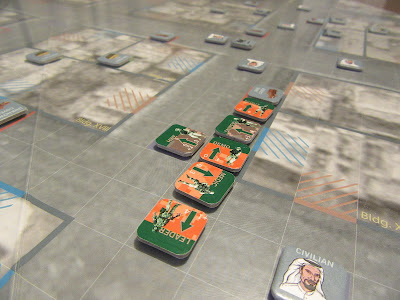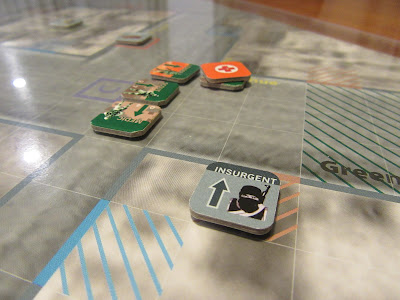A while ago I picked up Boots on the Ground by Worthington Games in a trade. It had been sitting in a trunk for the best part of 2024, but while I was searching for something quick-ish to play in order to test out my new plexiglass sheet, I wondered if it might be a good time to give it a try.
The rules are about six pages long, which is always a good start when you are looking for 'quick-ish'.
The game is designed to be played solitaire against a card-activated opponent, co-operatively against the same, or competitively, but I have not properly digested how the latter format works.
The system is simple: set up map of generic city; cover with your new plexiglass; populate map with markers (civilians, vehicles, items, insurgents) as per scenario instructions. Deploy your squad; activate the whole squad with limited action possibilities or activate an individual to use their special abilities; draw card for instructions on insurgent actions, perform actions. Repeat.
I chose the first scenario, requiring my squad of six to navigate their way down a long street to reach their objective, and to do so with at least four of the squad still alive. It's a 30 card (30 turns, in effect) scenario.
The first thing you notice is that the game's components are not especially appealing. The map has a sort of grainy 'satellite view' aesthetic with superimposed square grid. The counters are functional rather than artistic. But my set has already been clipped tidily by the previous owner, so that is an improvement on my own irregular clipping habits!
Game flow is similar to a first-person shooter. Insurgents suddenly appear in doors and windows to shoot at your team. You respond. You move close to a vehicle; you can't avoid it. Is it useful cover, or does it contain an IED? You approach civilians - are they harmless or insurgents in disguise? You flip the counter and see. There are lockboxes. Do you want to risk opening it? If yes, flip the counter and see.
 |
| And this one is an IED! Fortunately, our demolitions expert was able limit its effect. Can't say the same about the insurgent who appeared in the window; he has wounded the squad leader. |
 |
| A wider view of the map. |
Player input is mainly about positioning your team so that they can respond to threats while also looking to work towards the objective. Combat odds favour the player - your soldiers are elite - but with opposed die rolls and situational modifiers the advantage is not certain. It is only my first game but tactics here were not particularly sophisticated. Move towards the objective, shoot anyone in the way, keep your medic close by to treat wounds.
The card pull is the fun part. What will it be? Will it be an insurgents move and shoot card? Will it be an insurgents appear and shoot card? Will it be an insurgents take cover card? Will it be something else?
 |
| Two thirds of the team wounded and still two blocks from the objective. Do we halt and patch wounds, hoping for a lull in insurgent activity, or do we press on? |
In this scenario there seemed little need to use individual counter abilities. We wanted to keep everyone together and move then as a group if we could. The only one I activated individually was the medic, who was called upon to deal with the wounded and get them back on their feet.
At times it is brutal.
 |
| Another ambush. Our sniper killed! |
At this juncture we are fortunate enough to get some air support (two card-pulls in a row) which forces the insurgents to keep their heads down long enough for our medic to get around the rest of the team.
We keep moving. We have killed or wounded the visable insurgents, but then find the civilian in front of us is not a civilian after all. Oh dear!
 |
| Insurgent revealed. Another man wounded; we are lucky it wasn't worse. |
As we approach our objective the tension rises. Just half a block to go. We leave one of our wounded behind and press on with the four who can move as a group. Metres from safety disaster strikes.
 |
| An insurgent appears in the last doorway and shoots our demolition expert dead. |
The leader. medic and scout move to the objective; they call to the wounded heavy weapons expert to join them. He is wounded again in the sprint; the medic has to go and carry him to safety.
They make it, but only just.
 |
| Four survivors at the objective. |
 |
| The long road travelled. |
So what of the game? It is light and a little cartoonish. But that is good for me. I prefer it to be non-specific and based on generic situations rather than real events. I don't want to play a serious game on this topic; it is still too close and too many people are still affected.
As mentioned earlier, the play in this scenario was not sophisticated. The other scenarios will add complexity and no doubt the special abilities of the various squad members will come to the fore when there are different objectives and problems to surmount.
On the whole, it was a nice little diversion, and a great way to start two weeks off work.
I will look to play it again and will try the next scenario and see how it goes.
As for the plexiglass sheet, it really did the business!
